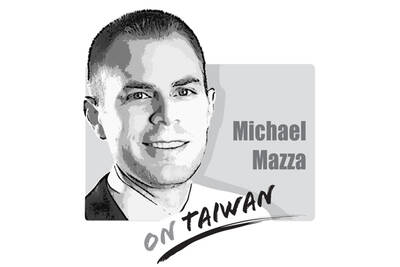The People’s Republic of China (PRC) celebrations of its 60th anniversary on Thursday will very much be a military affair. In fact, Beijing has been boasting that the nation’s newest nuclear missiles will be part of an arsenal of new weapons — 90 percent of which have never been paraded before.
Fifty-two types of weapons — all developed and made in China — will be on display during the parade, General Gao Jianguo (高建國), executive deputy director of the office of the National Day Military Parade Joint Command, has said.
The state-run People’s Daily newspaper, however, quoted Gao as saying that this unprecedented display of military might is not about intimidating China’s neighbors, but rather a celebration of the country’s achievements, adding that “a country’s military ability is not a threat to anyone, what is important is its military policy.”
This assertion, however, brings little comfort to those against whom such weapons would be used — mainly the people of Taiwan and US military personnel who would likely intervene on Taiwan’s side in the event of war.
Furthermore, while Gao is not altogether wrong in saying that military ability does not necessarily equate military policy, history is rife with examples of military policy being driven by a state’s military capacity — in other words, weapons designs drive policy rather than the other way around.
This is doubly worrying when, as a growing number of academics have pointed out, the “patience” of Chinese leaders regarding the Taiwan issue is, we are told, not infinite. While Chinese leaders were making similar pronouncements more than 10 years ago, “impatience” did not immediately entail that it would translate into military action. For one thing, a decade ago the balance on military power in the Taiwan Strait was still in Taiwan’s favor and China had yet to develop, or at least deploy, weapons meant to delay or deny the entry of US forces in the Strait.
The situation today is drastically different. Not only has the balance of power shifted in Beijing’s favor, but China has become far more assertive and, thanks to President Ma Ying-jeou’s (馬英九) pro-China policies, its leadership feels that its objective of unifying Taiwan and China may finally be within its grasp. Should domestic politics in Taiwan between now and 2012 threaten to derail moves toward that goal, and if the US continues to suffer from a weakened economy and a number of taxing military deployments, Beijing may have little compunction in using its growing arsenal to achieve its aims.
This year’s parade will also see a greater representation from all branches of the military, with many items having an offensive, rather than defensive, purpose. Generals in Beijing can say what they want, but the fact of the matter is, huge displays of offensive military equipment signal to the rest of the world, and more specifically the region, that China has the means to flex its muscles when necessary. Of the two key factors in a state’s decision to use force — intent and capabilities — Beijing is now showing that is has the latter. The main question now is whether Beijing will, over time, develop the intent.
While there are many ways for a nation to display its achievements, focus on the industrial-military nexus on national days, added to a strong sense of nationalism, has undertones of fascism. History shows us that fascism usually entails an intent to use force as an extension of government policies.
The saga of Sarah Dzafce, the disgraced former Miss Finland, is far more significant than a mere beauty pageant controversy. It serves as a potent and painful contemporary lesson in global cultural ethics and the absolute necessity of racial respect. Her public career was instantly pulverized not by a lapse in judgement, but by a deliberate act of racial hostility, the flames of which swiftly encircled the globe. The offensive action was simple, yet profoundly provocative: a 15-second video in which Dzafce performed the infamous “slanted eyes” gesture — a crude, historically loaded caricature of East Asian features used in Western

Is a new foreign partner for Taiwan emerging in the Middle East? Last week, Taiwanese media reported that Deputy Minister of Foreign Affairs Francois Wu (吳志中) secretly visited Israel, a country with whom Taiwan has long shared unofficial relations but which has approached those relations cautiously. In the wake of China’s implicit but clear support for Hamas and Iran in the wake of the October 2023 assault on Israel, Jerusalem’s calculus may be changing. Both small countries facing literal existential threats, Israel and Taiwan have much to gain from closer ties. In his recent op-ed for the Washington Post, President William
A stabbing attack inside and near two busy Taipei MRT stations on Friday evening shocked the nation and made headlines in many foreign and local news media, as such indiscriminate attacks are rare in Taiwan. Four people died, including the 27-year-old suspect, and 11 people sustained injuries. At Taipei Main Station, the suspect threw smoke grenades near two exits and fatally stabbed one person who tried to stop him. He later made his way to Eslite Spectrum Nanxi department store near Zhongshan MRT Station, where he threw more smoke grenades and fatally stabbed a person on a scooter by the roadside.
Taiwan-India relations appear to have been put on the back burner this year, including on Taiwan’s side. Geopolitical pressures have compelled both countries to recalibrate their priorities, even as their core security challenges remain unchanged. However, what is striking is the visible decline in the attention India once received from Taiwan. The absence of the annual Diwali celebrations for the Indian community and the lack of a commemoration marking the 30-year anniversary of the representative offices, the India Taipei Association and the Taipei Economic and Cultural Center, speak volumes and raise serious questions about whether Taiwan still has a coherent India